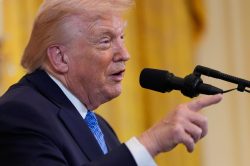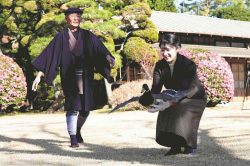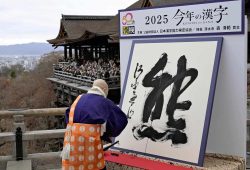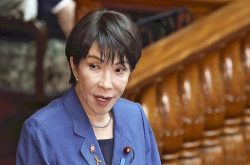
Ernie, a muppet from the popular children’s series “Sesame Street,” appears with new character Ji-Young, the first Asian American muppet, on the set of the long-running children’s program in New York on Nov 1.
November 15, 2021
What’s in a name? Well, for Ji-Young, the newest muppet resident of “Sesame Street,” her name is a sign she was meant to live there.
“So, in Korean traditionally the two syllables they each mean something different and Ji means, like, smart or wise. And Young means, like, brave or courageous and strong,” Ji-Young explained during a recent interview. “But we were looking it up and guess what? Ji also means sesame.”
At only 7 years old, Ji-Young is making history as the first Asian American muppet in the “Sesame Street” canon. She is Korean American and has two passions: rocking out on her electric guitar and skateboarding. The children’s TV program, which first aired 52 years ago this month, gave The Associated Press a first look at its adorable new occupant.
Ji-Young will formally be introduced in “See Us Coming Together: A Sesame Street Special.” Simu Liu, Padma Lakshmi and Naomi Osaka are among the celebrities appearing in the special, which will drop Thanksgiving Day on HBO Max, “Sesame Street” social media platforms and on local PBS stations.
Some of Ji-Young’s personality comes from her puppeteer. Kathleen Kim, 41 and Korean American, got into puppetry in her 30s. In 2014, she was accepted into a “Sesame Street” workshop. That evolved into a mentorship and becoming part of the team the following year. Being a puppeteer on a show Kim watched growing up was a dream come true. But helping shape an original muppet is a whole other feat.
“I feel like I have a lot of weight that maybe I’m putting on myself to teach these lessons and to be this representative that I did not have as a kid,” Kim said. But fellow puppeteer Leslie Carrara-Rudolph — who performs Abby Cadabby — reminded her, “It’s not about us … It’s about this message.”
Ji-Young’s existence is the culmination of a lot of discussions after the events of 2020 — George Floyd’s death and anti-Asian hate incidents. Like a lot of companies, “Sesame Street” reflected on how it could “meet the moment,” said Kay Wilson Stallings, executive vice-president of Creative and Production for Sesame Workshop, the nonprofit organization behind “Sesame Street.”
Sesame Workshop established two task forces — one to look at its content and another to look at its own diversity. What developed was Coming Together, a multi-year initiative addressing how to talk to children about race, ethnicity and culture.
One result was 8-year-old Tamir. While not the show’s first Black muppet, he was one of the first used to talk about subjects like racism.
“When we knew we were going to be doing this work that was going to focus on the Asian and Pacific Islanders experience, we of course knew we needed to create an Asian muppet as well,” Stallings said.
These newer muppets — their personalities and their looks — were remarkably constructed in a matter of a months. The process normally takes at least a couple of years. There are outside experts and a cross-section of employees known as the “culture trust” who weigh in on every aspect of a new muppet, Stallings said.
For Kim, it was crucial that Ji-Young not be “generically pan-Asian.”
“Because that’s something that all Asian Americans have experienced. They kind of want to lump us into this monolithic ‘Asian,’” Kim said. “So it was very important that she was specifically Korean American, not just like, generically Korean, but she was born here.”
One thing Ji-Young will help teach children is how to be a good “upstander.” “Sesame Street” first used the term on its “The Power of We” TV special last year, which featured Tamir.
“Being an upstander means you point out things that are wrong or something that someone does or says that is based on their negative attitude towards the person because of the color of their skin or the language they speak or where they’re from,” Stallings said. “We want our audience to understand they can be upstanders.”
In “See Us Coming Together,” Sesame Street is preparing for Neighbor Day where everyone shares food, music or dance from their culture. Ji-Young becomes upset after a kid, off screen, tells her “to go back home,” an insult commonly flung at Asian Americans and Pacific Islanders. But she feels empowered after Sesame Street’s other Asian American residents, guest stars and friends like Elmo assure her that she belongs as much as anyone else.
The fact that Ji-Young was created to counter anti-Asian sentiment makes her more special to Kim in some ways.
“I remember like the Atlanta shootings and how terrifying that was for me,” Kim said. “My one hope, obviously, is to actually help teach what racism is, help teach kids to be able to recognize it and then speak out against it. But then my other hope for Ji-Young is that she just normalizes seeing different kinds of looking kids on TV.”
Vanessa Leung, co-executive director of Coalition for Asian American Children and Families, is excited about Ji-Young. The organization was not involved in Ji-Young’s creation but previously consulted on anti-racism content for Sesame Workshop. It matters when Asian American families, especially with many of them being immigrant families, can see themselves reflected in an institution like “Sesame Street,” Leung said.
“It sparks curiosity and early understanding of the diversity of our community, the beauty in the diversity of our community,” Leung said.
Ji-Young will be heavily present throughout the new season, Stallings reassured. She also won’t just be utilized for content related to racial justice. She will pop up in various digital programs, live-action and animated.
As the new kid on the street, Ji-Young is looking forward to showing her friends and neighbors aspects of Korean culture such as the food. She loves cooking dishes like tteokbokki (chewy rice cakes) with her halmoni (grandmother). And she already has one “Sesame Street” friend who wants a sample.
“I would love to try it,” said Ernie, who joined Ji-Young’s interview. “You know, I’ve tried bulgogi. I really like bulgogi. I’m gonna guess that maybe old buddy Bert has not tried Korean food.”
Having already made several famous friends on “Sesame Street,” is there anyone Ji-Young still really wants to meet?
“The Linda Lindas because they’re so cool,” Ji-Young said, referring to the teenage punk rock band. “And they rock out and they’re cool girls and most of them are Asian. They’re my heroes. If we can get the Linda Lindas on ‘Sesame Street,’ I would show them around.”
"News Services" POPULAR ARTICLE
-

American Playwright Jeremy O. Harris Arrested in Japan on Alleged Drug Smuggling
-

Japan’s Nikkei Stock Average as JGB Yields, Yen Rise on Rate-Hike Bets
-

Japan’s Nikkei Stock Average Licks Wounds after Selloff Sparked by BOJ Hike Bets (UPDATE 1)
-

Japanese Bond Yields Zoom, Stocks Slide as Rate Hike Looms
-

Japan’s Nikkei Stock Average Buoyed by Stable Yen; SoftBank’s Slide Caps Gains (UPDATE 1)
JN ACCESS RANKING
-

Keidanren Chairman Yoshinobu Tsutsui Visits Kashiwazaki-Kariwa Nuclear Power Plant; Inspects New Emergency Safety System
-

Imports of Rare Earths from China Facing Delays, May Be Caused by Deterioration of Japan-China Relations
-

Japan Exports Rise in October as Slump in U.S. Sales Eases
-

Japan Pulls out of Vietnam Nuclear Project, Complicating Hanoi’s Power Plans
-

Govt Aims to Expand NISA Program Lineup, Abolish Age Restriction

























